Information Security
UUG Spring 2023
“The three golden rules to ensure computer security are: do not own a computer; do not power it on; and do not use it.” — Robert Morris
CIA Triad
- Confidentiality
- Integrity
- Availability
Confidentiality
- Assures that private or confidential information is not made available or disclosed to unauthorized individuals
Integrity
- Assures that information and programs are changed only in a specified and authorized manner
Availability
- Assures that systems work promptly and service is not denied to users
Which Aspect of the CIA Triad is Most Important?
Additional CIA Triad Concepts
-
Authenticity
-
The property of being genuine and being able to be verified and trusted
- Confidence in the validity of a transmission, a message, or message originator
-
-
Accountability
-
The security goal that generates the requirement for actions of an entity to be traced uniquely to that entity.
- Non-repudiation
-
Cryptography Concepts
-
Plaintext
- The item we plan on encrypting. Human-readable.
-
Key
- A secret.
-
Ciphertext
- The output of encryption. Not human-readable.
-
Cleartext
- The output of decryption (same as the input plaintext).
Kerckhoffs’s principle
-
Security must reside entirely in the secret key
-
Assume all other information is known by the attacker
-
This includes the:
- key-space (128-bit, 256-bit)
- algorithm (AES, RSA, ECC)
- hardware (Enigma)
Types of Ciphers
-
Block
-
Message is partitioned into fixed-size blocks (typically 64 or 128-bits)
- DES, AES, RSA
-
-
Stream
-
Encrypts a digital data stream one bit or one byte at a time.
- RC4, OTP (One-time pad)
-
Electronic Codebook (ECB)


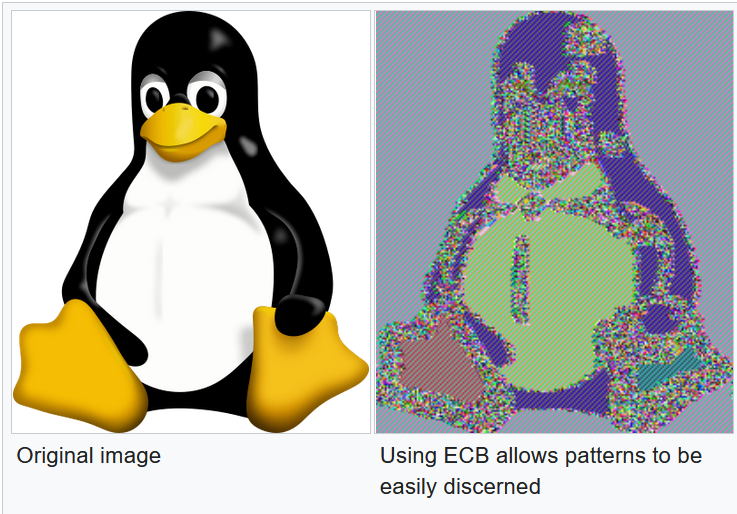
Cipher Block Chaining (CBC)
-
Duplicate data is not reflected in ciphertext
-
Malformed/incorrect blocks affect all following blocks


Output feedback (OFB)
-
Can prepare encryption and decryption in advance
-
Malformed/incorrect blocks affect only the current block


Types of Encryption
| Symmetric | Asymmetric |
|---|---|
| Single key | Two linked/related keys |
| Fast | Slow |
| Good for large data transfers | Good for small data transfers |
| Only provides confidentiality | Can provide confidentiality, authentication, and non-repudiation |
Symmetric Encryption

“Perfect” Encryption - One-Time Pad (OTP)
- Major rules of OTP:
- Key must be the same size as the message
- Key must be truly random
- Keys must never be reused
One-Time Pad Encryption
One-Time Pad Decryption
Is One-Time Pad practical to implement?
Feistel Cipher
- Created by German physicist Horst Feistel and patented the early 1970’s
- The Feistel Cipher is a design model (template) that is used to create different block ciphers.
- Blowfish, DES, RC5, Twofish
How the Feistel Cipher Works
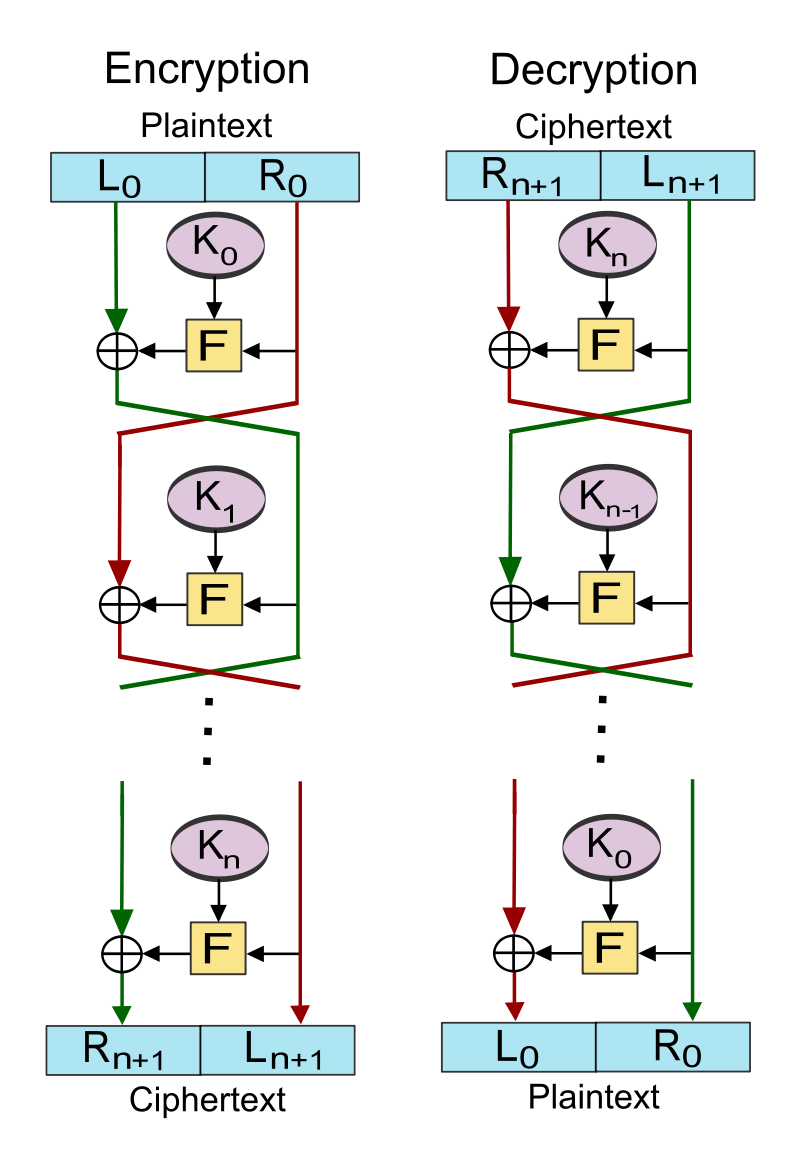
Data Encryption Standard
- A symmetric-key algorithm standardized in 1977
- Incorporates 16 Feistel Cipher rounds
- Has a block size of 64-bits
- Has a key size of 56-bits
- Purposely neutered by the NSA to make brute-force attacks easier
How the Data Encryption Standard Works
- Expansion: Function that takes 32-bit block increased to 48-bits
- Key mixing: XOR operation with the subkey
- Substitution: Lookup table
- Permutation: Bit shuffling
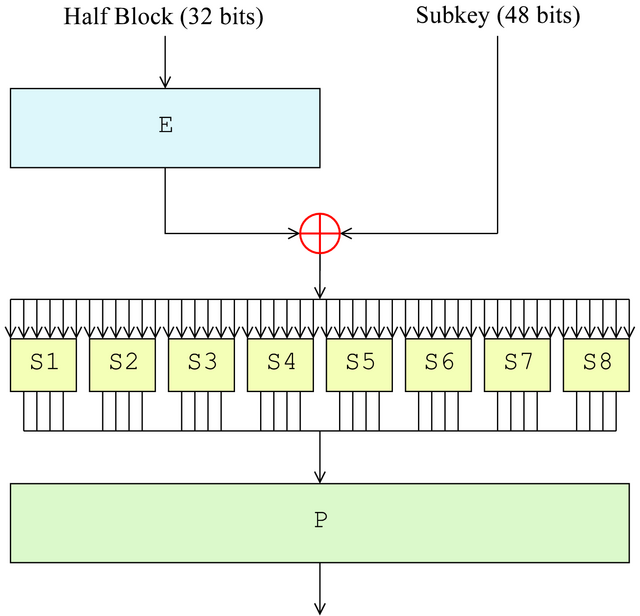
Triple DES (3DES)
- Published in 1981
- Incorporates 48 Feistel Cipher rounds
- Has a block size of 64-bits
- Has a key size of 168-bits (three 56-bit keys)
- Officially deprecated by NIST at the end of 2023
Advanced Encryption Standard (AES)
- Published in 1998 by Joan Daemen and Vincent Rijmen under the name Rijndael
- Selected by NIST in 2001 to replace DES
| Key length (bits) | Block size (bits) | # of Rounds | |
|---|---|---|---|
| AES-128 | 128 | 128 | 10 |
| AES-192 | 192 | 128 | 12 |
| AES-256 | 256 | 128 | 14 |
How AES works (1 of 2)
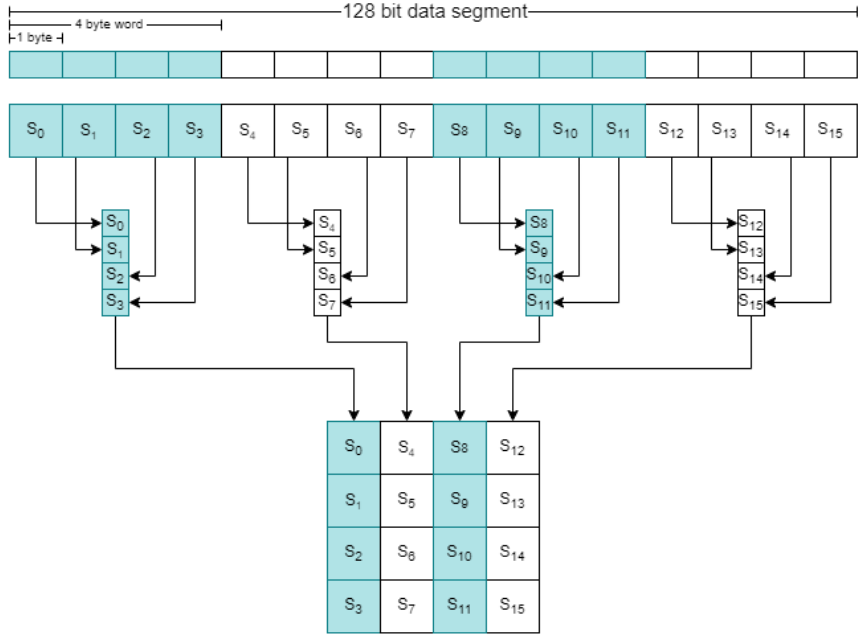
How AES works (2 of 2)
- SubBytes
- ShiftRows
- MixColumns
- AddRoundKey
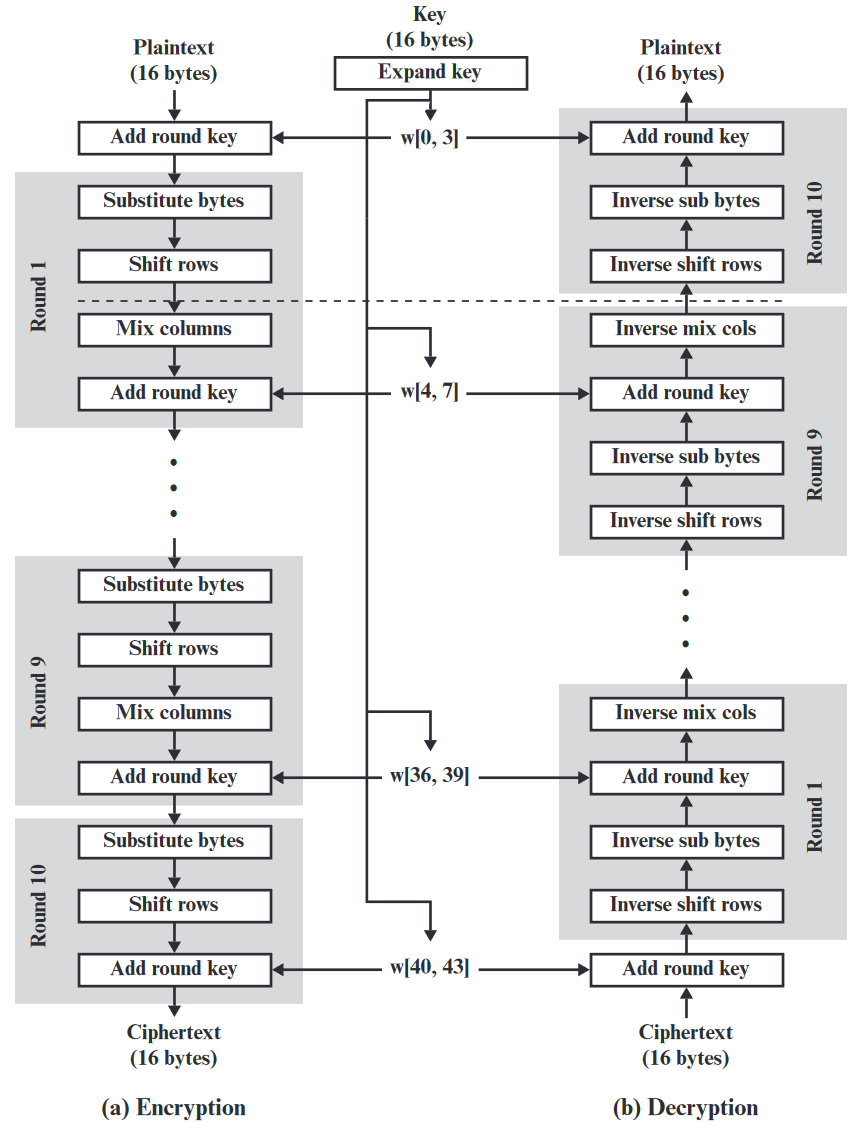
How AES works - SubBytes
- Byte-wise table lookup
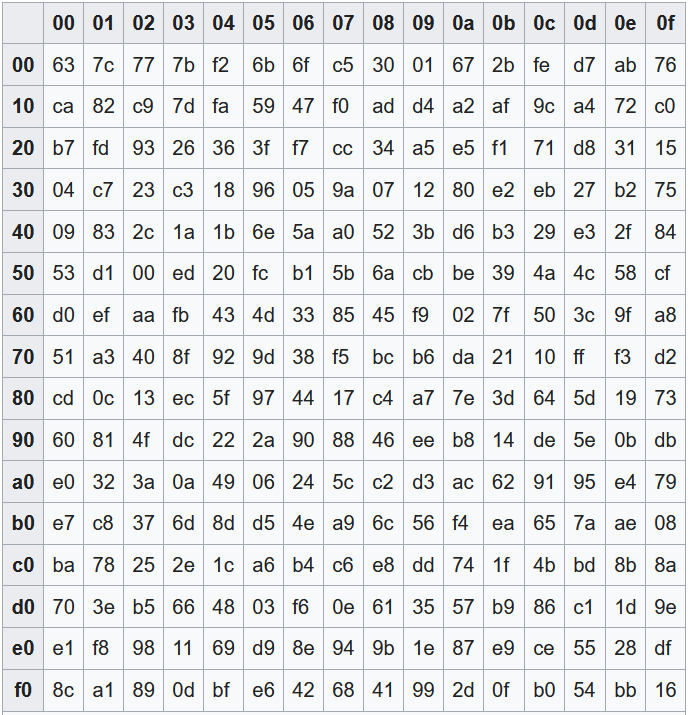
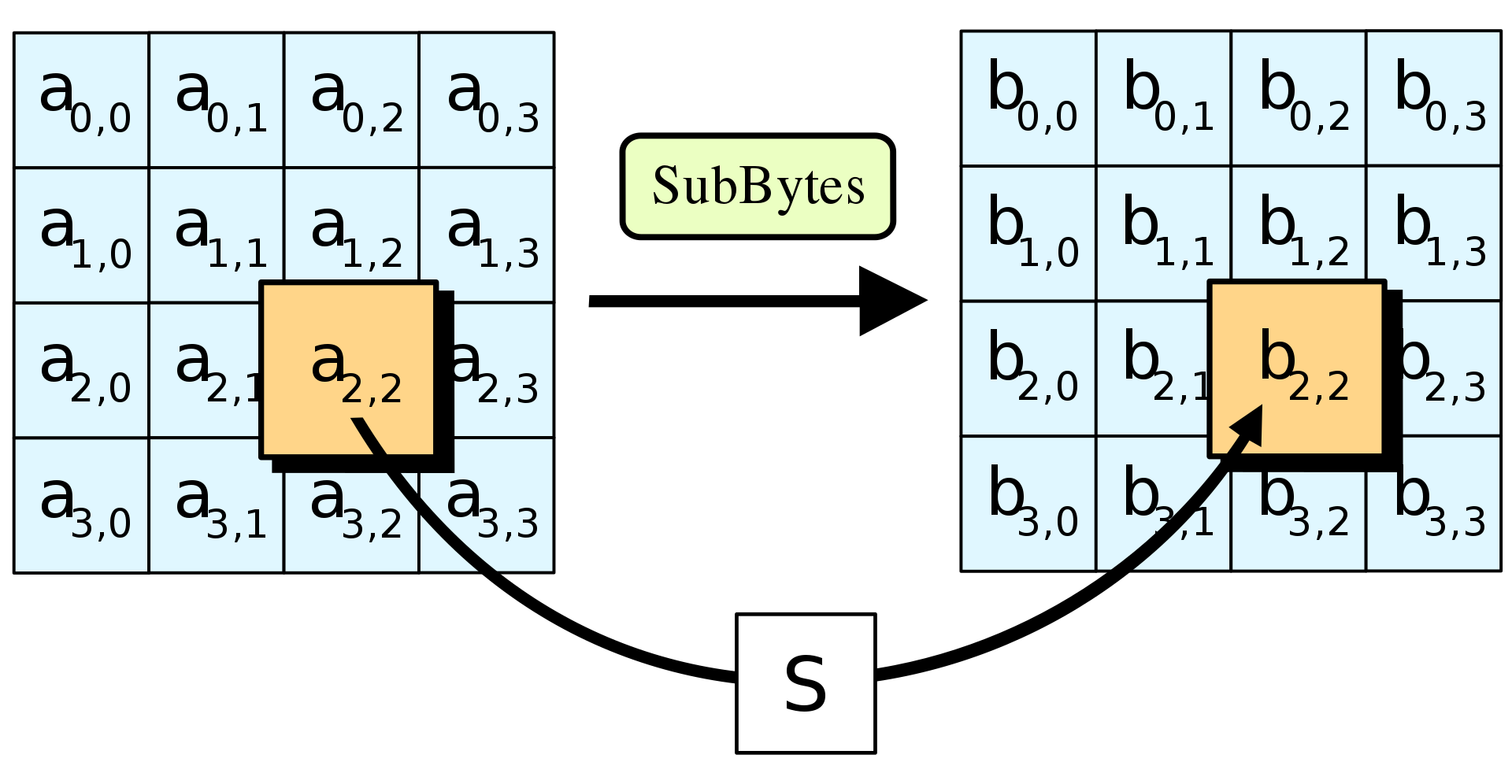
How AES works - ShiftRows
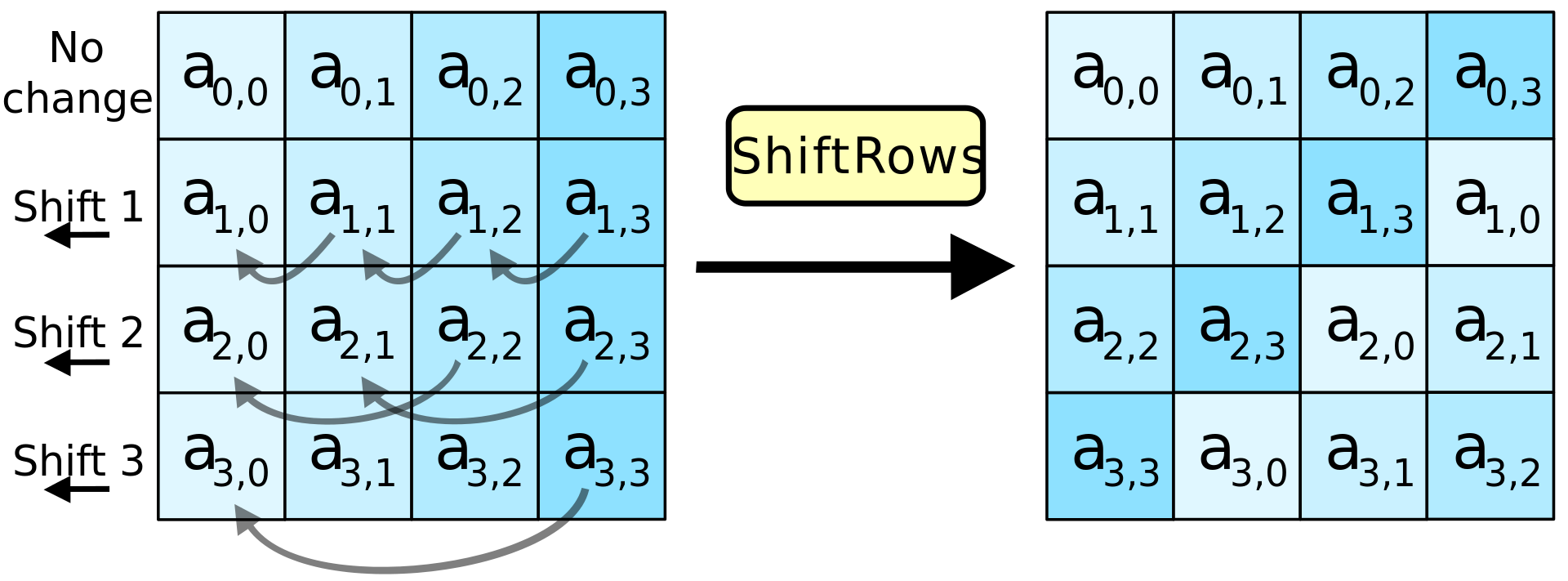
How AES works - MixColumns
- Shuffles bits using special matrix multiplication
- Uses polynomials, XOR, and modulo
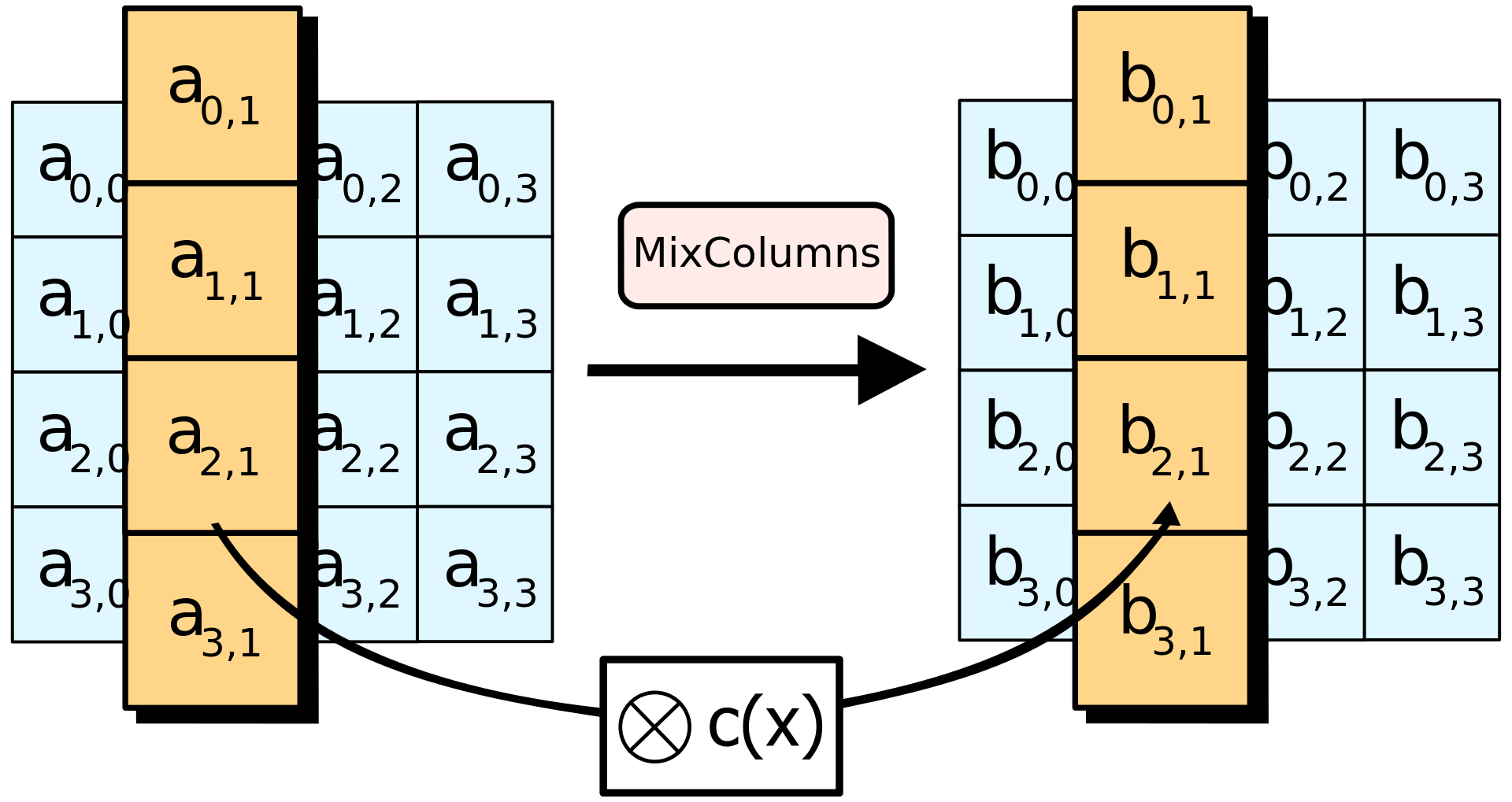
How AES works - AddRoundKey
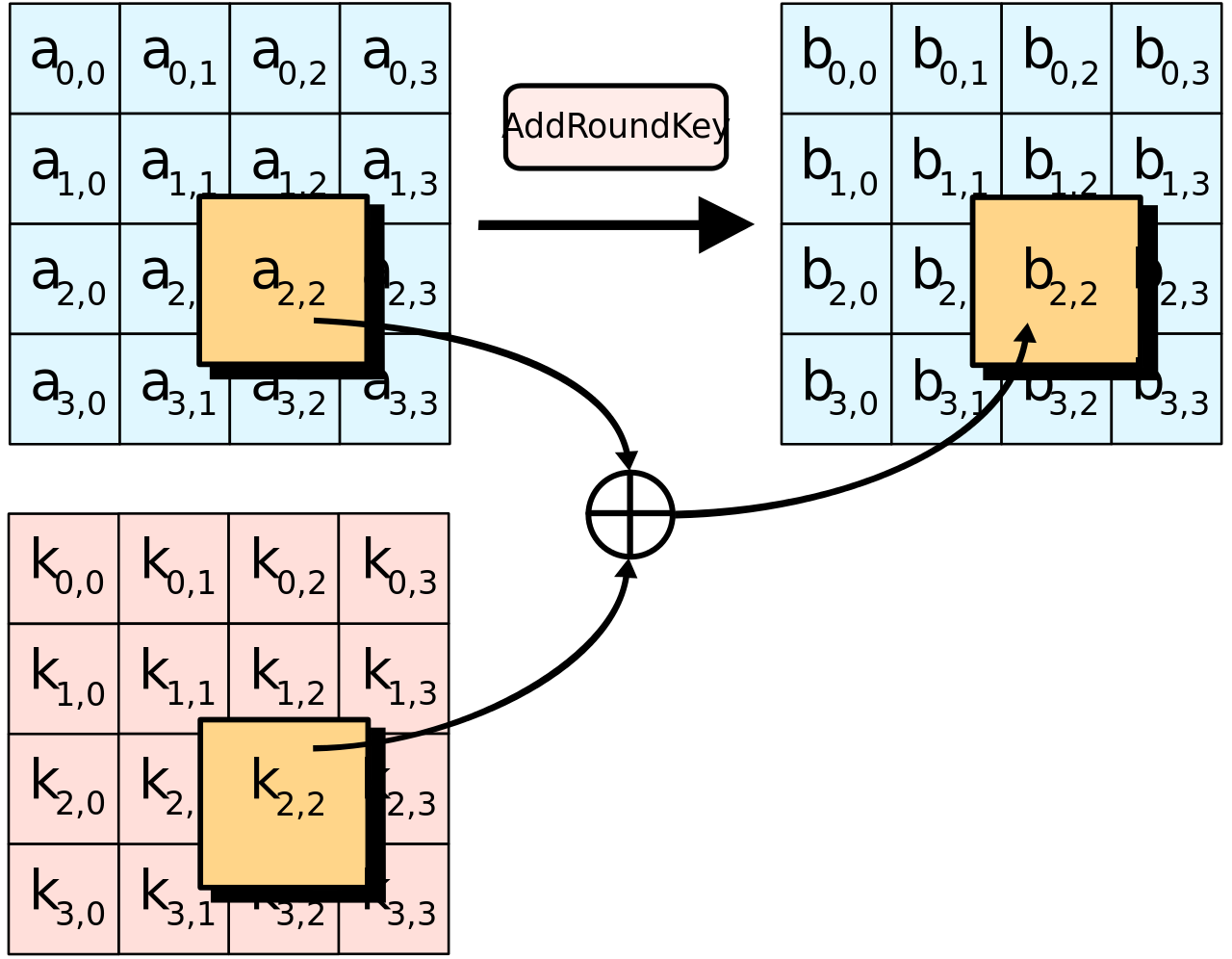
Asymmetric Encryption
Diffie Hellman key exchange (DH)
-
An asymmetric-key protocol conceived by Ralph Merkle that was published by Whitfield Diffie and Martin Hellman in 1976.
-
Previously been discovered by a British intelligence agency in 1969.
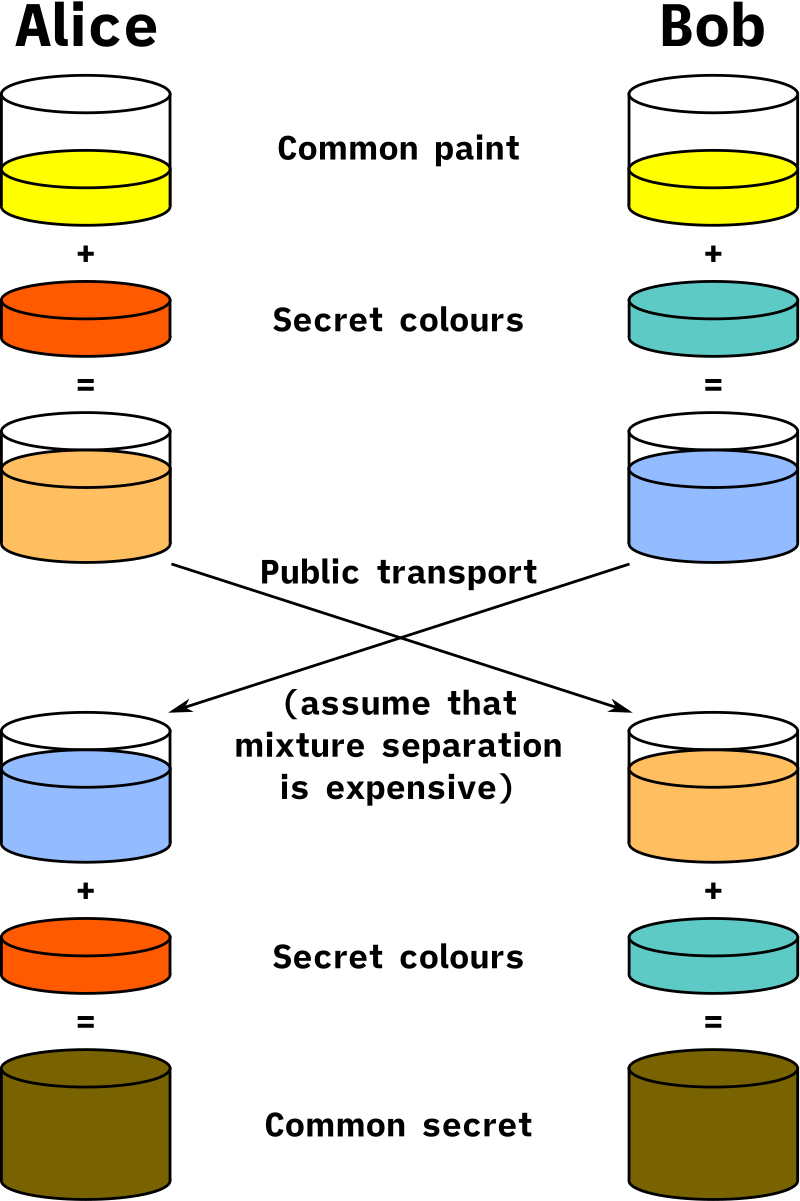
How DH Works (1 of 2)
- Alice and Bob publicly agree to use the modulus p=23 and base g=5
| Alice | Bob |
|---|---|
| α = 4 | β = 3 |
| A = gᵃ mod p | B = gᵇ mod p |
| A = 5⁴ mod 23 = 625 mod 23 = 4 | B = 5³ mod 23 = 125 mod 23 = 10 |
| sᵃ = Bᵃ mod p | sᵇ = Aᵇ mod p |
| sᵃ = 10⁴ mod 23 = 10000 mod 23 = 18 | sᵇ = 4³ mod 23 = 64 mod 23 = 18 |
How DH Works (2 of 2)
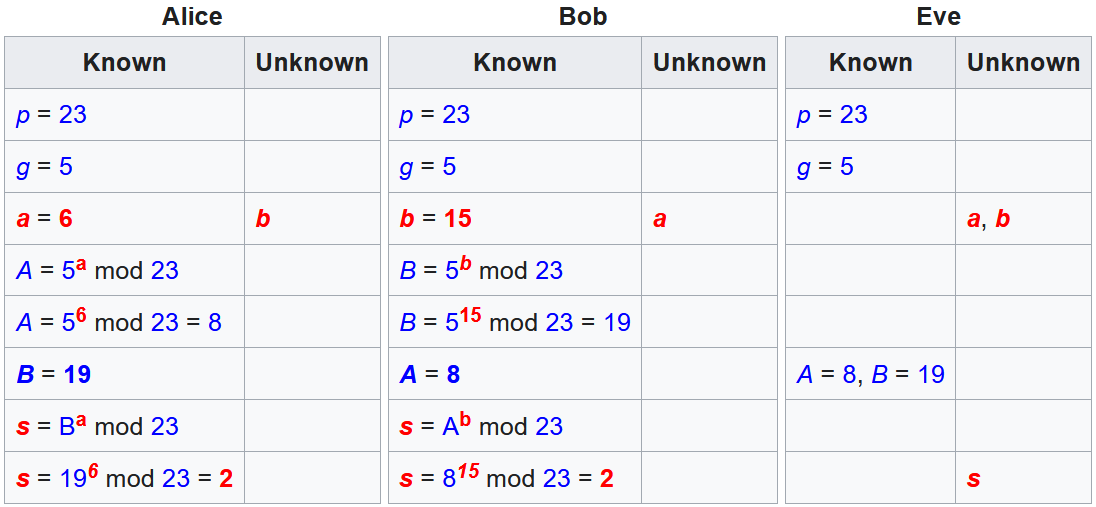
Rivest-Shamir-Adleman (RSA)
- An asymmetric-key algorithm published in 1977 by Ron Rivest, Adi Shamir, and Leonard Adleman
- Relies on the difficulty of factoring the product of two large prime numbers
- Common key lengths in RSA
- 1024, 2048, 3072, 7680, 15360
How RSA Works (1 of 2)
- p, q : chosen random prime integers (private)
- n : product of p and q, modulus for the public/private keys (public)
- Φ(n) : (Phi of n) Euler totient
- e : chosen integer that is (public):
- greater than one and less than the totient
- co-prime to the totient
- shares no common factors with the totient
- d : calculated multiplicative inverse of e mod the totient (private)
How RSA Works (2 of 2)
-
Public key
- {e, n}
-
Private key
- {d, n}
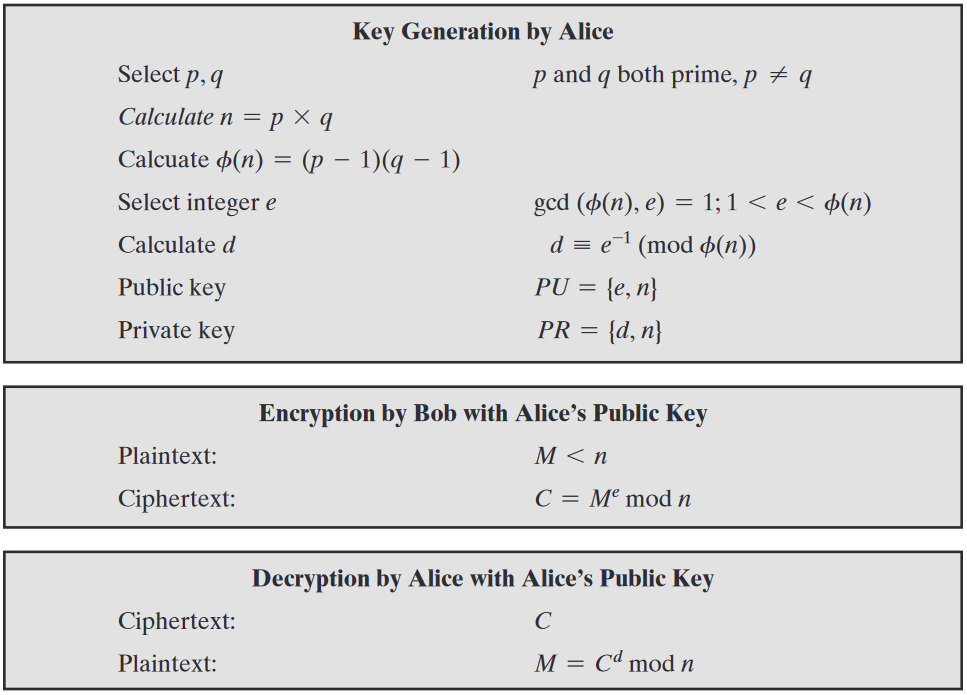
RSA Example (1 of 3)
-
p = 5, q = 7
-
n = 5 × 7 = 35
-
Φ(n) = (5 - 1) × (7 - 1) = 4 × 6 = 24
-
e = 1 < 5 < 24
- can check if co-prime using Euclid’s Algorithm (GCD)
-
d = 5⁻¹ mod 24 = 5
- can solve this using Extended Euclid’s Algorithm (XGCD)
RSA Example (2 of 3)
-
Public Key: {5, 35}
-
plaintext (M): 23
- ciphertext (C) = Mᵉ mod n
-
C = 23⁵ mod 35 = 6436343 mod 35 = 18
RSA Example (3 of 3)
-
Private Key: {5, 35}
-
ciphertext (C): 18
- cleartext (M) = Cᵈ mod n
-
M = 18⁵ mod 35 = 1889568 mod 35 = 23
Elliptic-Curve Cryptography (ECC)
- An asymmetric-key cryptography approach independently suggested by Neal Koblitz and Victor S. Miller in 1985.
- Relies on the discrete logarithm problem over the elliptic curve y² = x³ + ax + b
- Elliptic-curve calculations are more computationally demanding allowing keys to be smaller than the equivalent RSA counterparts
How ECC Works (1 of 4)
- Publicly agreed on curve (a=2, b=2, q=17):
- y² = x³ + ax + b
- y² = x³ + 2x + 2
- Publicly agreed on generator (G)
- G=(5,1)
- Publicly agreed order of G (n)
- n = 19
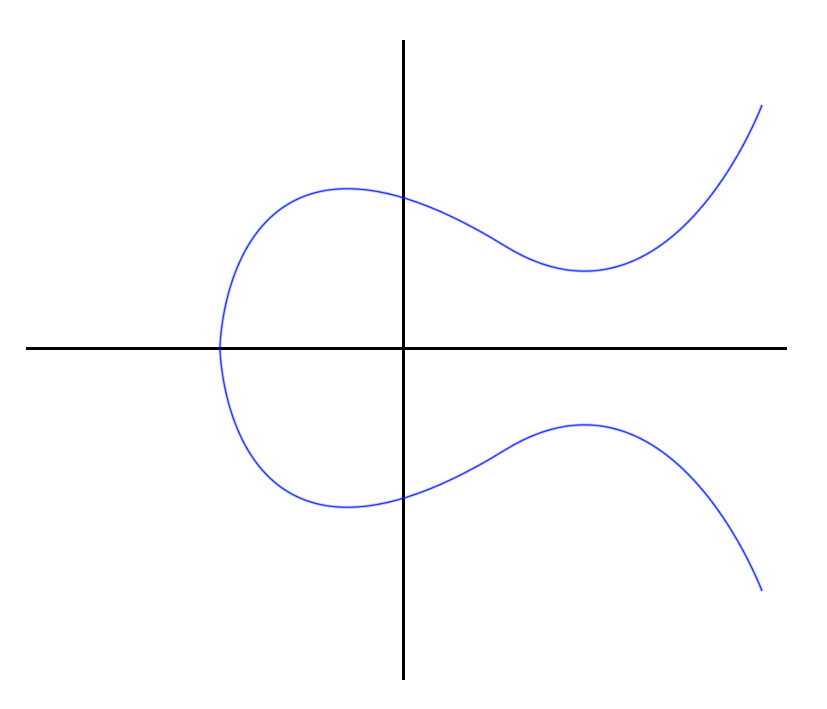
How ECC Works (2 of 4)
- G=(5,1)
| Alice | Bob |
|---|---|
| α = 3 | β = 9 |
| Α = 3G | Β = 9G |

How ECC Works (3 of 4)
-
Alice (3G)
- G + G = 2G
- 2G + G = 3G (10,6)
-
Bob (9G)
- G + G = 2G
- 2G + 2G = 4G
- 4G + 4G = 8G
- 8G + G = 9G (7,6)

How ECC Works (4 of 4)
| Alice | Bob |
|---|---|
| Α = 3G = (10,6) | Β = 9G = (7,6) |
| αΒ = 3Β = 3(9G) = 27G = 8G = (13,7) | βΑ = 9Α = 9(3G) = 27G = 8G = (13,7) |
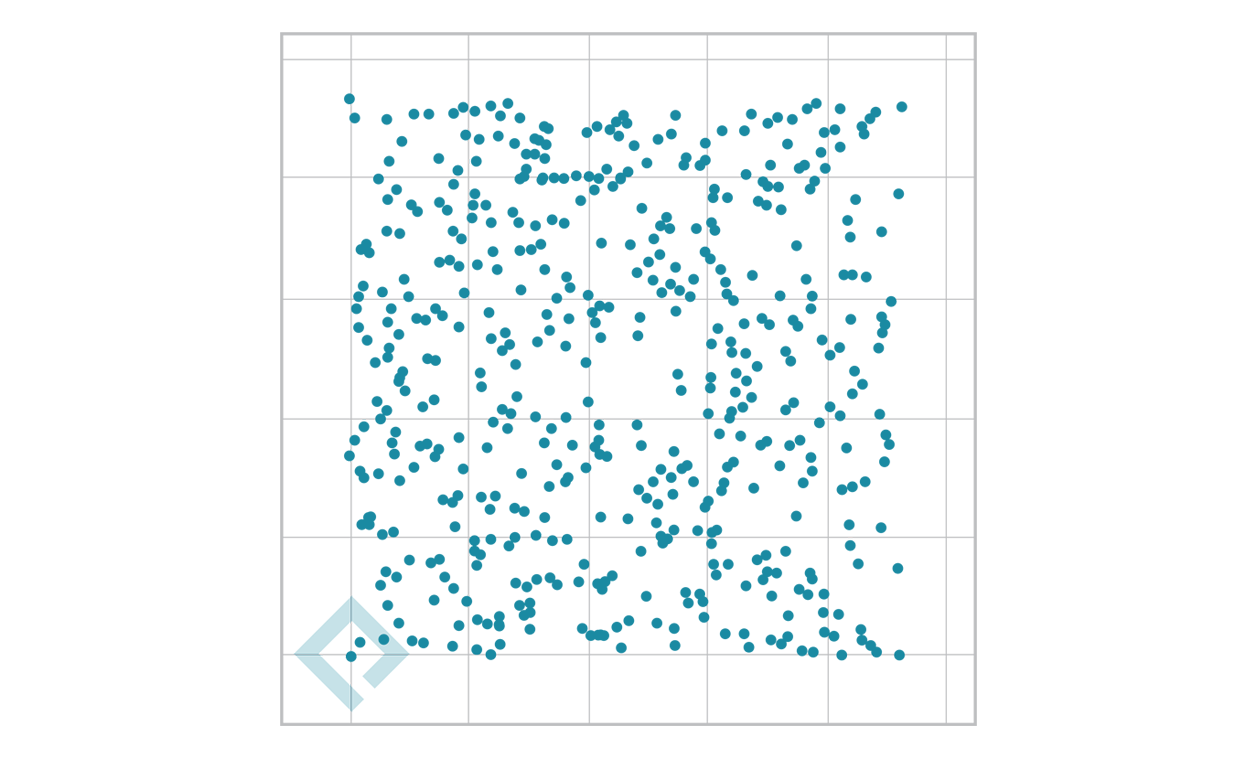
Comparison of Symmetric and Asymmetric Algorithms
| Security Bits | Symmetric Encryption Algorithm | RSA | ECC |
|---|---|---|---|
| 80 | 1024 | 160 | |
| 112 | 3DES | 2048 | 224 |
| 128 | AES-128 | 3072 | 256 |
| 192 | AES-192 | 7680 | 384 |
| 256 | AES-256 | 15360 | 512 |
Symmetric Encryption Quantum Threats
-
Grover’s Algorithm
-
A quantum brute-forcing algorithm that is effective against AES
-
Takes AES from O(N) to O(√N)
-
2¹²⁸ → 2⁶⁴
-
2¹⁹² → 2⁹⁶
-
2²⁵⁶ → 2¹²⁸
-
-
Asymmetric Encryption Quantum Threats
-
Shor’s Algorithm
- A quantum algorithm for finding prime factors of an integer (DH, RSA) and discrete logarithms (ECC)
Hashing
Password Hashing
-
password123
-
SHA-256
- ef92b778bafe771e89245b89ecbc08a44a4e166c06659911881f383d4473e94f
-
password123D;%yL9TS:5PalS/d
- 9C9B913EB1B6254F4737CE947EFD16F16E916F9D6EE5C1102A2002E48D4C88BD
-
password123D;%yL9TS:5PalS/d + iterations
- fc91e3c64406e6afb456303d93ecb7c22b7f7ddb7f89d7e3ca52de8c10c16525
Storing Hashed Passwords - LAN Manager
-
Morpheus:1010:B902F044A44585DF93E28745B8BF4BA6:D5D630DA69EBD8AB040D77BE7BB046DD:::
-
username:user_id:LM_hash:NTLM_hash
-
14 character password
- Converted to uppercase
- Unused space filled with null bytes
- Split in half with parity character added (two 8-byte segments)
- Both halves are encrypted with DES and concatenated together
Storing Hashed Passwords - New Technology LAN Manager
-
Morpheus:1002:aad3b435b51404eeaad3b435b51404ee:d5d630da69ebd8ab040d77be7bb046dd:::
-
username:user_id:LM_hash:NTLM_hash
-
14 character password
- RC4 encryption
Storing Hashed Passwords - sha512crypt
-
Morpheus:$6$ykumbyCz$kb1zUhrB3wROIN1uoI94gfmAMjlTeeVhKkEtEZHYeIFIqD6CBiAQAlFB9uqYHHVO1doCNJbV56tC4gJi/L0ng0:1001:1001::/home/morpheus:/bin/sh
-
username:hash_algorithm:user_id:group_id:home_directory:default_shell
man 5 crypt - sha512crypt
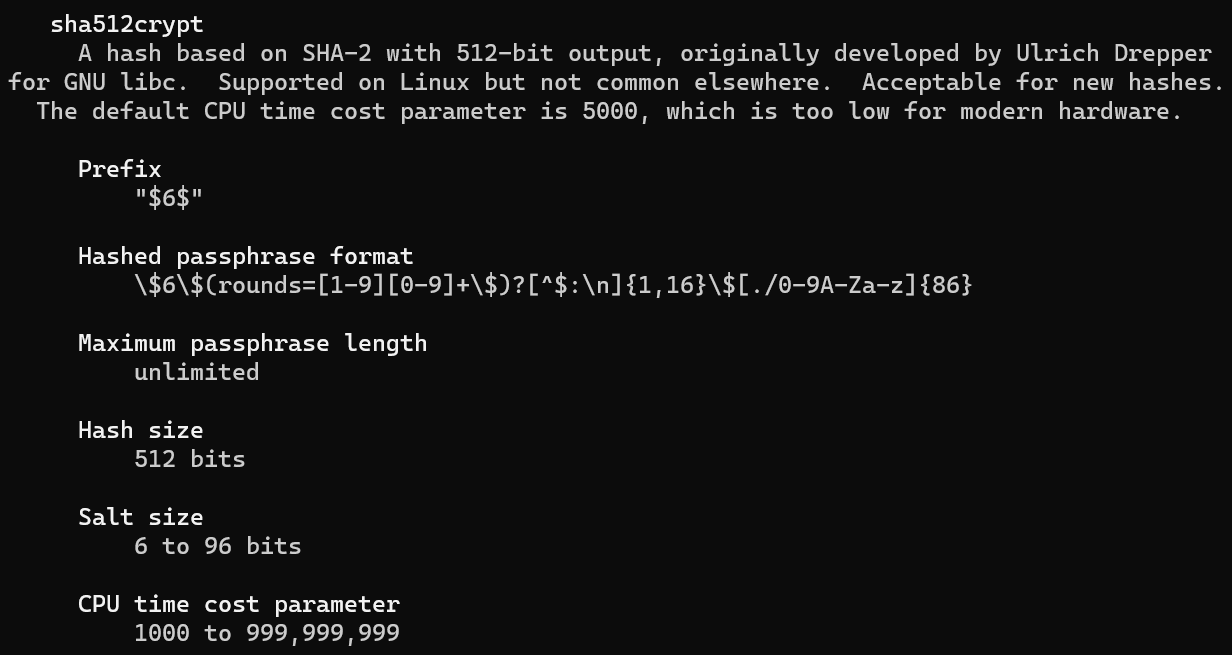
man 5 crypt - yescrypt
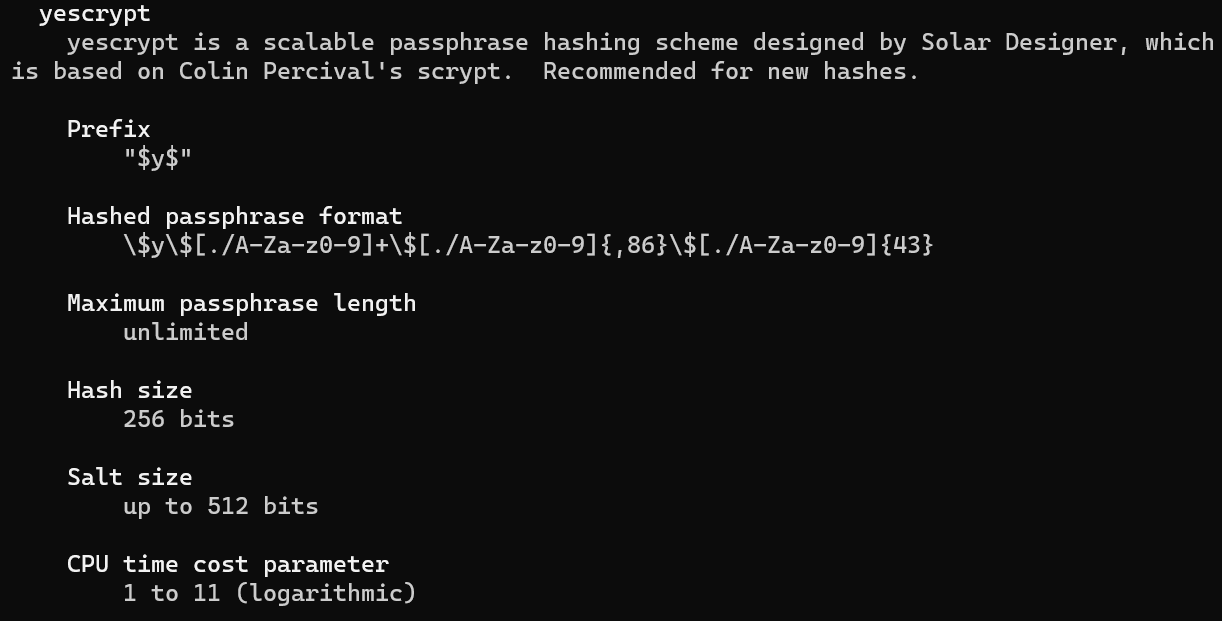
Password Hashing Explained
-
Hashing protects against dictionary attacks
-
Salts protect against rainbow tables
- Precomputed hashes
-
Iterations increase the computation time
-
Hash + Salt + Iterations:
- susceptible to dictionary attacks if the algorithm is known




